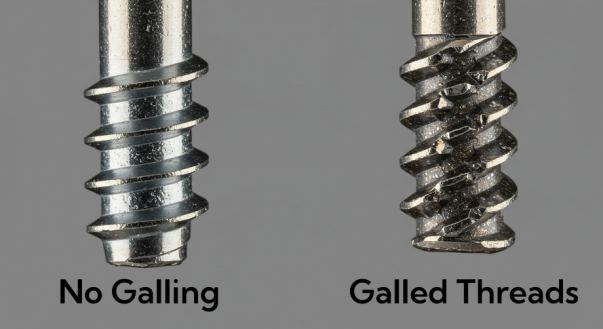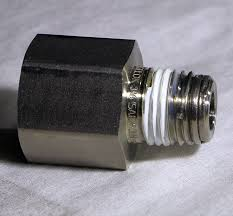Aluminium Galling: Causes, Risks, and Proven Fixes
 Jul 12,2025
Jul 12,2025

Galling is a common form of failure in every application where there is friction or a lack of lubrication. It is often observed with soft materials due to lower hardness. This article presents a comprehensive part of information on Al galling, including why it occurs, its effects, and how you can stop it. This article is going to be very helpful, especially if you have observed many failures in your applications of AI. So, let's begin by introducing galling and how it is different from fretting:
What Is Galling? -Galling Meaning in Engineering
Galling and fretting are both surface-related failures that often occur due to friction and poor lubrication. But there is some difference between them. The major difference between fretting and galling is the type of sliding between the surfaces. For instance, if the sliding is continuous, then wear type is galling, and if it is oscillatory, then you will call it fretting.
What Is Aluminium Galling?

Galling, a type of wear, in which the first metal's surface adheres and then tears under sliding contact. Galling often leaves visible scars on the metal surfaces. The following table shows key factors for galling:
|
Contact Condition |
Debris Type |
Visual Clues |
|
High friction |
Metal flakes |
Scratches, torn material |
|
Dry sliding |
Oxidized particles |
Discolouration, roughness |
Common Warning Signs on Threads & Slides
If you see a torn metal on an M8 bolt thread, you will see an uneven surface or difficulties in disassembling parts. These are the symptoms of galling on Al parts.
Why Galling Matters for Part Failure and Cost
Galling results in surfaces tearing and ultimately results in failures. It matters because when a lot of money is consumed making such parts, and galling occurs results in parts failures and money wastage.

Why Does Aluminium Gall?
In this section, we will explain why Aluminium galls by sharing important factors with you. So, these are the reasons behind aluminium galling:
Material Factor
Material factor is the main reason for Al galling, as one surface is harder as compared to other, softer material will face galling issues.
Softness
Suppose you join two materials, i.e. aluminium 6061-T6 of 95 HB hardness with stainless steel of 170 HB, Al will gall due to its lower hardness, i.e. soft surface as compared to stainless steel.
Oxide Layer
When load is applied to Aluminium, its oxide layer can be prone to tear, leaving the surface bare, which is easy to bond.
Thermal Expansion
Al has higher thermal expansion, so at higher temperatures its surface expands and increases the risks of galling and friction. You can take the example of extrusion dies reaching 400°C.
Operating Loads and Sliding Speed
If you apply higher loads or increase the sliding speed, it will result in heating of the surface, then expansion and galling, etc.
Temperature and Contaminant Effects
As mentioned earlier, higher temperature increases the risk of galling. Similarly, if there is any debris, they will make galling worsen, e.g. dies at high temperatures lose their lubrication.
Common Applications & Failure Points
Galling is a critical issue in many applications and leads to failures and expensive repairs, and downtime. High friction and sliding speed are the main causes of galling. Let's discuss it in major fields:
Threaded Fasteners (Bolts, Nuts, Inserts)
In aerospace, galling occurs commonly, especially in wing-skin fasteners. You can identify it through these symptoms:
- Difficulty turning bolts
- Visible metal transfer on threads
- Stripped or deformed fastener heads
Sliding Bearings and Guide Rails
In pick-and-place robots, due to repetitive motion, Al bearing can gall. If there is no lubrication, the friction will be higher and the following will be the effects:
- Jerky or uneven movement
- Scratches on rail surfaces
- Increased wear debris
Extrusion Press Tools and Forming Dies
A 400-degree Celsius temperature in Al dies, removes lubricants and causes metal transfers. Further issues are given below, which can be solved through hard coatings or lubricants:
- Aluminium chips fusing to the die surfaces
- Frequent downtime for acid cleaning
- Reduced part quality due to surface defects
Key Factors That Accelerate Galling
In this section, you are going to study some major reasons you don't know that further accelerate the galling process.
Alloy Pairing & Hardness Mismatch
When you make a pair of different metals with different hardnesses. Such as if you make a pair of aluminium 6061 and steel, aluminium will gall for sure due to soft skin as compared to steel.
Surface Roughness and Micro-Burrs
If you use Surfaces rougher than Ra 1.6 µm, triple will be a galling risk.
Contact Pressure, Torque, and Misalignment
If you overtighten a bolt, it increases contact pressure, torque and sometimes misalignment, which accelerates galling.
Lack of Lubrication or Wrong Lubricant
If you use lithium grease at 150-degree Celsius, it fails. So, the gallium risk is increased due to the wrong lubricant. You can use PTFE paste.
How to Prevent Galling in CNC Machining?
If galling occurs in CNC machining, it will result in damage to parts as well as the equipment. We can avoid it by smart design. Further ways are discussed below in this section:
Add Extra Clearance (≥0.05 mm)
Add extra clearance of about ≥0.05 mm because 0.05-0.1 mm clearance between moving parts reduces contact pressure, minimising galling risk.
Specify Fine Surface Finish (Ra ≤ 0.8 µm)
Any rough surface can trap debris and increase the risk of galling, so always produce a surface finish of Ra ≤ 0.8 µm to avoid galling.
Use Rolled, Not Cut, Threads
Rolled threads are harder than cut threads, which reduces the galling chances, because it will be difficult to tear the surface if it is hard.
Add Lead-In Chamfers on Thread Starts
You can use a 45° chamfer because it will ease assembly, preventing misalignment and initial galling.
Pair Aluminium with Harder Mates
You can pair Aluminium with harder components to reduce adhesion. You can use anti-seize lubricants such as PTFE-based, etc.
Galling in Other Metals: Stainless Steel, Titanium, Copper
Galling is not a common issue with only aluminium; there are many other metals which face this issue as well. You can read about these materials prone to galling in this section:
Galling Stainless Steel
Stainless steel often faces the issue of galling, but not every grade. For instance:
|
Property |
304 (Austenitic) |
430 (Ferritic) |
|
Galling Risk |
High (work-hardens) |
Low (softer) |
|
Cause |
Surface bonds under pressure |
Less adhesion tendency |
|
Prevention |
Anti-seize paste required |
Often unlubricated |
Titanium Cold-Weld Under Vacuum Load
Titanium faces cold-weld, which is not a gall but like gallium phenomena. Due to high reactivity, under high stresses, it self-fuses (cold-weld). It is common in satellite components.
Galling in CNC Machining
In CNC machining, when friction between tools and aluminium workpieces increases, it causes metal transfer and so the gall. Galling leads to surface tears and poor surface efficiency. You can avoid this issue by using the following tips:
- Optimise speeds
- Use polished carbide tools
- Use appropriate lubricant and coolant
- Avoid dull tools
Conclusion
Galling is a common issue in metals, which is a form of surface failure. It results in surface wear and poor surface finish. It is not common with aluminium only, but other metals such as stainless steel and titanium can be prone too. The factors, such as an improper pair of metals, high pressure, softness, higher thermal expansion, etc., further increase the galling risks. This issue can be avoided using lubricants, optimising speed and using polished carbide tools, etc.
If you want to get high-quality one-stop CNC custom processing services, come to TUOFA Technology.
Aluminium Galling FAQs
Does WD-40 prevent aluminium galling?
For a short time, yes, but anti-seize lubricants are more effective.
Which aluminium grade resists galling best?
7075-T6 has a good hardness of 150 HB, so it resists galling best.
How to remove a galled aluminium fastener safely?
First, apply penetrating oil, then heat it and use locking pliers to remove a galled aluminium fastener safely.
 Tel/WeChat:
Tel/WeChat:  Email:
Email: 
 Home
Home
 Motor Shafting Made Simple: Process, Types & Custom Options
Motor Shafting Made Simple: Process, Types & Custom Options 







